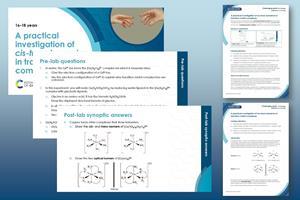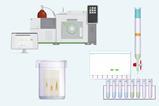Crystalise understanding of cis-trans isomers with this practical investigation
This resource accompanies the article Teaching isomerism at post-16 in Education in Chemistry where you can find more ideas and support for teaching this topic.
Learning objectives
- Recognise why transition metal complexes can show cis-trans isomerism.
- Identify further examples of structural and stereoisomerism in transition metal complex ions and other species.
- Apply your knowledge and understanding of transition metal chemistry to the synthesis of the cis-trans isomers of copper(II) aminoethanoate.
In this resource, learners investigate isomerism in transition metal complexes and apply their knowledge and understanding to the synthesis of the cis- and trans- isomers of copper(II) aminoethanoate. Encourage learners to make links with other topics such as quantitative chemistry, amino acids and isomerism in organic compounds with the pre- and post-lab questions in the presentation.
How to use this resource
This resource centres around the synthesis of the cis- and trans- isomers of copper(II) aminoethanoate. Owing to the time constraints of a typical lesson you can choose to complete the activity in two parts. You can store the cis- copper(II) aminoethanoate and the filtrate from Part 1 between lessons ready for isomerism to trans-copper(II) aminoethanoate in Part 2.
Prior to completing the synthesis, ask learners to complete the pre-lab questions in the presentation. These questions are designed to help learners understand the chemistry involved in the synthesis. Run through the answers immediately before starting the practical.
Learners synthesise copper(II) aminoethanoate by the reaction of aqueous copper(II) ions and glycine. The product contains a mixture of the cis- and trans- isomers in equilibrium. As the cis- isomer crystallises faster it is isolated first.
Once the cis- isomer is isolated, it is isomerised to produce a sample of the trans- isomer. The trans- isomer is more thermodynamically stable and is less soluble and so can be isolated from the equilibrium mixture of the two isomers after sustained heating.
The presentation provides details of the synthesis and isomerism, along with scaffolding to support learners with the steps needed to calculate the percentage yield of the cis-isomer.
Four post-lab synoptic questions and answers are provided to encourage learners to retrieve prior knowledge and make links between the topics. Set these as homework or ask learners to complete them during Part 2 of the practical activity, while the solution is being heated under reflux.
Use the pre- and post-lab questions as a standalone activity if time or resource constraints prevent completion of the synthesis. Alternatively, get learners to synthesise the cis- isomer only and ask them to compare its appearance with a pre-made sample of the trans- isomer.
The extension activity is an open question connected to the use of copper(II) aminoethanoate as a fertiliser. Use this as a discussion as learners complete the practical or as a follow-up question. Additionally, you can ask learners to research and present the work of Edith Ellen Humphrey who synthesised isomers of octahedral complexes and was a pioneering woman in chemistry.
More resources
- Find support for introducing organic chemistry topics with our CPD article Teaching organic chemistry post-16.
- Show learners the role isomerism plays in the synthesis of molecular motors and find more questions to test understanding of E/Z isomerism, with this article and accompanying resource.
- Introduce John, who is developing new medicines for infectious diseases such as malaria, using this video job profile.
Technical notes
Read our standard health and safety guidance and carry out a risk assessment before running any live practical.
Equipment and materials for both preparations (per group)
- Splash-proof googles
- Hot water bath or electric heating mantle
- 25 cm3 measuring cylinder
- 2 × 100 cm3 conical flasks
- 2 × 250 cm3 conical flasks
- Water bath
- -10–110°C thermometer
- Filter funnel and fluted filter paper
- 2 × watch glasses
- 50 cm3 round-bottom flask (Quickfit)
- Condenser (Quickfit) to fit the 50 cm3 round-bottom flask
- Bunsen burner, tripod and gauze
- 2 × sample tubes
- Ethanol (DANGER: flammable), 25 cm3
- Copper(II) ethanoate monohydrate (DANGER: harmful; irritant), 2.0 g
- Glycine, 2.5 g
- Distilled water, 50 cm3
- Ice
Safety and hazards
- Wear splash-proof goggles.
- Work in a well-ventilated laboratory.
- Ethanol is flammable: work away from naked flames.
Full preparation information is available in the teacher and technician notes.
Part 1 – synthesis of cis-Cu(H2 NCH2 COO)2.H2 O
Method
- Using a measuring cylinder, measure out 25 cm3 of ethanol into a 100 cm3 conical flask and place the flask in a hot water bath at 65°C.
- Using a measuring cylinder, measure 25 cm3 of distilled water into a 250 cm3 conical flask. Weigh out 2.0 g (0.01 mol) of copper(II) ethanoate monohydrate and add it to the flask. Place the flask in the water bath and stir the mixture until the solid dissolves. When the solution reaches 65°C, pour the warm ethanol into the copper(II) ethanoate solution.
- Using a measuring cylinder, measure 25 cm3 of distilled water into a 100 cm3 conical flask. Weigh out 1.5 g (0.02 mol) of glycine and add it to the flask. Place the flask in the water bath. Stir the mixture until the solid dissolves. When the solution reaches 65°C, pour it into the flask containing the copper(II) ethanoate solution.
- Cool the mixture in an ice bath. Light blue needles should crystallise. Filter the cold mixture through a fluted filter paper. Collect the filtrate in a clean 250 cm3 conical flask and keep it for the synthesis of trans -Cu(H2 NCH2 COO)2.H2 O.
- Open up the filter paper and lay it on a watch glass. Cover the crystals with a piece of clean filter paper and leave to dry in a fume cupboard at room temperature.
- Label a sample tube with the name of the product, your name and the date. Weigh the labelled sample tube and record its mass.
- Scrape the dried crystals into the weighed sample tube. Weigh the tube again. Record its mass.
Calculations
Ask learners to calculate the theoretical yield and the percentage yield. Scaffolding for the calculation is on Slide 9 of the presentation if learners need support.
Part 2 – synthesis of trans-Cu(H2 NCH2 COO)2.H2 O
Method
- Weigh 1.5 g of cis -Cu(H2 NCH2 COO)2.H2 O and 1 g of glycine into a 50 cm3 round-bottom flask.
- Use a measuring cylinder to pour 10 cm3 of the filtrate from the synthesis of cis-Cu(H2 NCH2 COO)2.H2 O into the flask, fit a condenser and reflux the mixture for one hour (use a hot water bath or electric heating mantle).
- Filter the hot mixture through a fluted filter paper to obtain blue-violet platelets of trans-Cu(H2 NCH2 COO)2.H2 O. Note that if the mixture all dissolves during the reflux, then the cis-product will re-precipitate not the trans-isomer.
- Open up the filter paper and lay it on a watch glass. Cover the crystals with a piece of clean filter paper and leave to dry in a fume cupboard at room temperature.
- Label a sample tube with the name of the product, your name and the date.
- Scrape the dried crystals into the weighed sample tube. It is not possible to get a meaningful value for the percentage yield as the exact quantity of cis -Cu(H2 NCH2 COO)2.H2 O is not known.
Downloads
Cis-trans isomerism presentation
Presentation | PDF, Size 0.42 mbCis-trans isomerism teacher technician notes
Handout | PDF, Size 0.29 mbCis-trans isomerism student sheet
Handout | PDF, Size 0.27 mbCis-trans isomerism presentation
Presentation | PowerPoint, Size 0.68 mbCis-trans isomerism teacher technician notes
Editable handout | Word, Size 5.46 mbCis-trans isomerism student sheet
Editable handout | Word, Size 5.32 mb
Additional information
The practical experiment included in this resource is part of our Challenging plants: fertiliser practicals collection of experiments, developed in association with Reckitt Benckiser. It was developed and additional content added by Catherine Smith.
























No comments yet